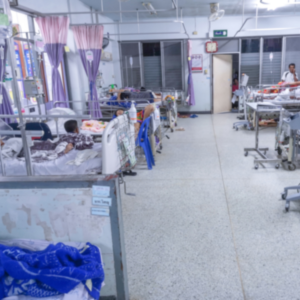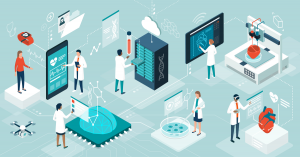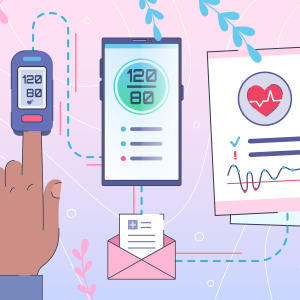Estimated reading time: 3 minutes
The past couple of months has taught us that this Pandemic doesn’t discriminate against who it infects, and with that being said, the quality of care administered is so critical in order to save as many patients as possible.  At the end of 2020, more hospital beds were filling with COVID-19 leaving some healthcare professionals to get creative with how they deliver care, branching out to hallways, and even parking garages. With full-time centers running out of rooms, it’s important to present At-Home Healthcare offerings to their patients to the elderly and at-risk crowd, especially to help stop the in-contact spread of the virus and that’s where remote patient monitoring solutions can come into play.
At the end of 2020, more hospital beds were filling with COVID-19 leaving some healthcare professionals to get creative with how they deliver care, branching out to hallways, and even parking garages. With full-time centers running out of rooms, it’s important to present At-Home Healthcare offerings to their patients to the elderly and at-risk crowd, especially to help stop the in-contact spread of the virus and that’s where remote patient monitoring solutions can come into play.
Brightening the Path with Technology Solutions
This has been the year of digital experiences for everyone, whether working for employers from digital parameters of Zoom or WebEx, or attending virtual Christmas parties with friends or participating in a ‘Happy Hour’ of sorts from behind the screen of a mobile device. Though it’s not entirely new to the scene, this past year has brought Telehealth experiences out of the woodwork and expanded upon this opportunity with more services and offerings, simplifying the healthcare experience for all. Over 95% of U.S. Hospitals use a certified Electronic Health Record (EHR) platform; these databases work to provide better care, simplify data collection, decrease overhead costs, and reduce mortality rates for the chronically ill patients cycling through the system.
Working hand-in-hand, EHR and Telehealth services are able to simplify data entry processes, because without the duo, procedures would result in mundane do-overs and repeating of tasks to get the job done. That sort of slip-up can waste valuable time and effort when it comes to workplace productivity. When physicians and healthcare staff take notes during a Telehealth visit, that information is transported directly into the patient’s health records, reducing the chances of any errors popping up, and ensuring providers have access to the most accurate and updated information about their patients.
Read More from VARTECH Nation: Flattening the Curve with Telehealth Services
 Essentially working hand-in-hand with Telehealth, remote patient monitoring (RPM) works to gather critical information points from patients, determining whichever angle care should be delivered. In today’s world, patients have often adopted a semblance of an RPM device, such as a FitBit or an Apple Watch to track health credentials such as heart rate, pulse, blood pressure, and so much more. With COVID-19, there isn’t much we can do on the consumer standpoint, other than regularly monitoring temperature checks and ensuring that one’s taste and smell are still intact. For the many who’ve suffered from the virus, their road to recovery hasn’t been a seamless one, for complications seem to reappear after quarantine holds are lifted, which can be confusing for patients to determine if they would need to return to a care center or not. To make matters worse, recent studies have also found that COVID-19 can potentially lead to long-term heart and lung damage, amongst a list of other detrimental side effects, no matter how old patients admit to be.
Essentially working hand-in-hand with Telehealth, remote patient monitoring (RPM) works to gather critical information points from patients, determining whichever angle care should be delivered. In today’s world, patients have often adopted a semblance of an RPM device, such as a FitBit or an Apple Watch to track health credentials such as heart rate, pulse, blood pressure, and so much more. With COVID-19, there isn’t much we can do on the consumer standpoint, other than regularly monitoring temperature checks and ensuring that one’s taste and smell are still intact. For the many who’ve suffered from the virus, their road to recovery hasn’t been a seamless one, for complications seem to reappear after quarantine holds are lifted, which can be confusing for patients to determine if they would need to return to a care center or not. To make matters worse, recent studies have also found that COVID-19 can potentially lead to long-term heart and lung damage, amongst a list of other detrimental side effects, no matter how old patients admit to be.
A Patient-First Initiative for All
A huge goal for RPM is to curb readmissions in an effort to save healthcare professionals from working overboard in such a cyclical pattern. This way, staff members can focus on new and more needy cases that come down the line. Worried patients are able to utilize wearable devices that will record their vital signs and report such data to a database that their primary care physicians and other healthcare professionals can view and monitor through for any irregularities. Such proactive managed care can connect the patient with their physician virtually, ensuring excellent service is provided all the while. Nurses will call patients to determine if their patients are experiencing symptoms such as nausea and shortness of breath, or any sudden surge or drop in fever temperature.
There are so many use cases for Telehealth and RPM technologies today, including enabling the ongoing monitoring of patients outside of the traditional clinical setting, eliminating the need for non-essential in-person visits to stop and slow the spread of the virus, reducing overall healthcare costs, and even serving as an essential, early warning system for COVID-19 based detection, especially for asymptomatic individuals. In this current public health crisis that we are all experiencing a world of hurt, and these Telehealth strategies can help to bring digital healthcare to those who may not have ever had access to it before. Each healthcare provider that has the ability to construct this type of software service, can modify it the way they choose to, according to which functionalities they want to allow their patients access to.

